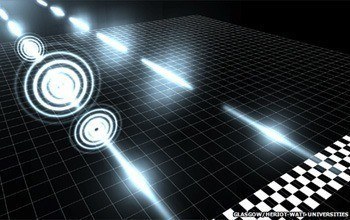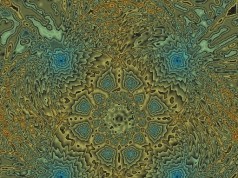Light slows down in water. That’s a known experimental fact. The usual explanation is that, when light advances through water, it collides with water molecules. So it zigs and zags through the water, and this zig-zagging action slows it down.
This makes no sense (sorry, noble predecessors!)
After showing why it makes no sense, I will present my solution, STRUCTURED LIGHT. The reasoning squarely contradicts Einstein on the photon, and its triumph helps to demonstrate how right it is.
If the zig-zag collision theory of the slowing down of light were true, light would lose energy during these collisions.
It’s simple basic physics: if particle P hits particle W, and particle P’s momentum changes, W momentum also changes, and so does its energy. Energy is conserved (at least for times long enough), so as P gives energy to W, P loses energy. Here P is for Photon, of course, and W for Water. (Remember Quantum Physics does not contradict Classical Mechanics; instead, it gives it a SUBSTRUCTURE, in the finer domain that subtends the Classical domain.)
So the slow-down through collision theory predicts that light will lose energy when it goes through water.
However, it does not. Light comes out of water at the same exact color, thus energy, as it came in. Laser light keeps being laser light under water. It surely would not if every single photon of the beam had to collide with a water molecule. (Notice in the link how confused research presently is about optics and liquids; my proposed reasoning is at a scale thousands of times smaller.)
The proposed theory for the slowing down of light is obviously wrong. Sorry, honorable predecessors!
So, what’s my solution?
Absolute Wave Theory.
According to said theory, propagating photons are NOT particles (Va De Retro, Einsteinas!)
What are photons?
Einstein proposed that photons (“Lichtquanten”) were points. He made it up. He had no proof, whatsoever, that this was true. It just sounded good. Worse: he did not need point-particle photons to explain the photoelectric effect. That error has poisoned the well of physics for 110 years. That thousands of physicists repeated what Einstein said, and that he was given the Nobel Prize for this exact idea, is no proof of its validity, as far as I am concerned. That makes me special.
But I have very good reasons to believe photons are not points. Because:
- I don’t know what points are. Not only I do not know what points are physically, I don’t even know what they are, mathematically. (By the way, I know Real Analysis and some Model Theory, so I am not as naïve as I sound to the unwary.)
- Light diffracts and bends around corner. Isolated photons do this. How could they do it, if they were not spread about transversally?
Here is my conclusion: Photons are structured waves. This basically means that they have some width.
This is now experimentally supported. What was published in Science on January 22, 2015?
Spatially structured photons that travel in free space slower than the speed of light. (Daniel Giovannini1,*, & Al.)
https://sciencemag.org/content/early/2015/01/21/science.aaa3035
“Abstract: That the speed of light in free space is constant is a cornerstone of modern physics. However, light beams have finite transverse size, which leads to a modification of their wavevectors resulting in a change to their phase and group velocities. We study the group velocity of single photons by measuring a change in their arrival time that results from changing the beam’s transverse spatial structure. Using time-correlated photon pairs we show a reduction of the group velocity of photons in both a Bessel beam and photons in a focused Gaussian beam. In both cases, the delay is several micrometers over a propagation distance of the order of 1 m. Our work highlights that, even in free space, the invariance of the speed of light only applies to plane waves.”
So what do I propose?
That water structures photons propagating through it. Structuring is what slows light down. Instead of having just one mask, as in the Glasgow experiment, we have thousand within one wavelength of light. Thus, instead of being slowed down .0001%, it’s slowed down of the order of 10% or more.
As in the Glasgow experiment, photons are not “particles”, they are spread about (they have a “TRANSVERSE structure”).
When a photon enters water, should it NOT hit a water molecule, the photonic wave will get endowed with a complex topology of non-trivial genus (because the non-linear wave that constitutes the photon has to have avoided nuclei and orbiting electrons, and the only way it can do that is by evolving holes in the right places).
As a photon passes a water molecular group, it slows down a bit. The water molecules act like the mask the physicists applied to slow down the beam photons in their experiment. Those breaking episodes pile up, and integrate in a global slow-down.
Frequency, thus energy, is unaffected.
Some may object that the theory is obviously false: should not the slow-downs pile up, and thus, the thicker the water, the more photons will slow down?
No. In the slowing down of the Structured Photons in vacuum, the slowing down is necessitated by the collapse of the photon back into a linear wave. It’s a one time event. However, in water, when the photon has acquired a structure which is enough like a sieve, after going around enough water molecules, it needs time to restructure. So over that distance, it has slowed down. Then the process repeats.
Let me quote a bit more from the violation of light speed Glasgow University paper (from behind its pay wall):
“The speed of light in free space propagation is a fundamental quantity. It holds a pivotal role in the foundations of relativity and field theory, as well as in technological applications such as time-of-flight measurements. It has previously been experimentally established that single photons travel at the group velocity (20). We have now shown that transverse structuring of the photon results in a decrease in the group velocity along the axis of propagation. We emphasize that in our full-aperture experiments, no pre- or post-selection is applied to the spatially structured photons, and that the group velocities are always compared over the same propagation distance, much as if they were in a race. The effect can be derived from a simple geometric argument, which is also supported by a rigorous calculation of the harmonic average of the group velocity. Beyond light, the effect observed will have applications to any wave theory, including sound waves.”
The authors have declared that they could not see any application of their theory, in particular not in cosmology.
However, I just found one, in everyday physics.
There is no experimental for Einstein’s views on the spatial the nature of the photon as a particle, there is plenty of evidence against it (the latest being Structured Light).
By contrast there is increasing evidence for the Absolute Wave Theory. Einstein and company, bless their souls, pontificated about a lot of things they did not know anything about. That photons were point-particles is one of them. Time to move on.
Patrice Ayme






